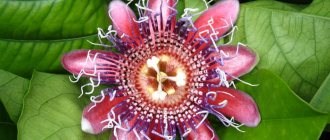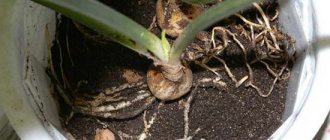Author: Elena N. https://floristics.info/ru/index.php?option=com_contact&view=contact&id=19 Category: Garden plants Published: February 01, 2019Last edits: November 05, 2020
- Garden care rules
- Digging up crocuses (when to dig)
- Spring crocus (Crocus vernus)
Crocus (lat. Crocus) , or saffron , forms a genus of herbaceous corms of the Iris family. In nature, saffron crocus grows in the steppes, forests and meadows of the Mediterranean, Central, Southern and Northern Europe, Asia Minor and Central Asia and the Middle East. Scientists have described about 80 species and 300 varieties of crocuses. The name “crocus” comes from a Greek word meaning “thread, fiber,” and the word “saffron” comes from an Arabic word that translates as “yellow,” which is the color of the stigma of the crocus flower. Crocus is mentioned in Egyptian papyri - philosophers and doctors wrote about it. For modern gardeners, crocus is interesting because it is one of the most beautiful primroses - early spring flowers. However, not everyone knows that there are many crocuses that bloom in the fall.
Planting and caring for crocuses
- Planting: spring-flowering species are planted in autumn, autumn-flowering species in summer.
- Flowering: spring species bloom for 2-3 weeks in April, autumn species - in September-October.
- Lighting: bright sunlight.
- Soil: permeable light loams, some species are comfortable even in heavy clay soils.
- Watering: will only be needed if there was no snow in winter and no rain in spring.
- Fertilizing: complete mineral fertilizer in the spring on snow and potassium-phosphorus fertilizer during flowering. Organics cannot be used.
- Reproduction: by daughter bulbs, and spring species can also be propagated by seeds.
- Pests: field mice, wireworms, aphids, thrips.
- Diseases: viral diseases, gray rot, fusarium, penicillosis, sclerotial rot.
Read more about growing crocuses below.
When to plant crocuses
The timing of planting a spring flower depends on the species. Spring - for autumn varieties; autumn – for early flowering species. In spring, late-blooming varieties of crocuses are planted. For saffron, choose a sunny place. Planting is carried out in moist soil, in warm but not hot weather. For early, beautiful flowering, spring-flowering saffron is planted in early autumn.
The depth of the bulb depends on the quality of the soil:
- deepen into light soil to the depth of two bulbs;
- in heavy soil - the bulb is planted to a depth of its size.
The distance between the bulbs is 3-5 cm. After planting, the bulbs are watered.
By planting saffron in the fall, the bulbs will take root and overwinter well, and in the spring they will diversify the garden with bright flowering.
Important! If you plant a spring variety in the summer, the saffron will be able to bloom at the time of frost, which will lead to the death of the plant. And when planted in cold October, the bulb may not take root in the cold soil.
Features of growing crocuses
Crocus is a low-growing plant, reaching a height of about 10 cm. The flattened or rounded bulbs of crocuses reach a diameter of 3 cm, they are covered in scales and have a bunch of fibrous roots. The stem of crocuses does not develop. Appearing during or after flowering, narrow, linear, basal leaves are collected in a bunch and covered with scales. Single goblet-shaped crocus flowers with a diameter of 2 to 5 cm of white, cream, blue, lilac, purple, yellow or orange, blooming on a short leafless peduncle, are surrounded by membranous scales. There are varieties of crocuses with spotted or two-colored colors. Mass flowering of crocuses lasts from two to three weeks. Types and varieties of crocuses are divided into 15 groups.
Diseases and pests
The greatest danger to crocuses is represented by large pests - mice, squirrels with great appetite eat the tubers, which leads to their destruction. You can counteract this by placing each individual tuber in a wire basket when planting, which can limit their reproduction, or by physically repelling the animals.
As for diseases, they more often affect tubers kept in poor conditions before planting or after digging. Therefore, special attention should be paid to the dryness and darkness of the room.
Planting crocuses in open ground
When to plant
Spring crocuses are planted in the ground in the fall, and autumn-blooming ones in the summer; a sunny site is chosen, although crocuses grow well in partial shade and even in the shade. The soil for growing crocuses is preferably light, dry, loose and nutritious. When preparing a site for crocuses, it is advisable to place fine gravel or coarse river sand in the soil for drainage. As an organic additive, compost, rotted manure or peat with lime are added to the soil for digging, since crocuses do not like acidic soils. Ash is added to clay soil. For those species that do not tolerate wet soils, arrange high beds with crushed stone or gravel as a drainage layer. Planting material must be free from flaws and damage.
In the photo: How crocuses bloom
Autumn planting
To see crocuses bloom in the spring, their bulbs are planted in open ground in September. Planting crocuses in loose soil involves planting the bulb to a depth twice its size. If the soil is heavy, then a depth of one size will be sufficient. The average distance between the bulbs is from 7 to 10 cm. After planting, the area is watered.
- Nivyanik: growing from seeds, types and varieties
Do not thicken the planting, because crocuses grow in one place for 3 to 5 years, and during this time one bulb becomes overgrown with a whole colony of children, and the area with crocuses turns into a continuous carpet of flowers. After the five-year period, the crocuses need to be planted.
Planting crocuses for forcing
Many flower growers miss their favorite garden flowers in winter, so they grow them in their apartment even in winter. The easiest way to grow a bouquet is from bulbs, including crocuses. Large-flowered Dutch varieties are most suitable for forcing. Crocus bulbs of approximately the same size are planted from five to ten pieces in shallow wide pots in order to obtain a whole bouquet of primroses by the appointed time. The soil for crocuses planted for forcing must be neutral, loose, air- and water-permeable.
We described the procedure and conditions for forcing crocuses in a separate article.
Crocus bulbs are not thrown away after flowering; they continue to be watered and even fed with a weak solution of complex mineral fertilizers for indoor plants. When the leaves begin to turn yellow, watering is gradually reduced until it stops completely. After the leaves have completely dried, the bulbs are removed from the pot, cleaned of soil, wrapped in a napkin, placed in a cardboard box and stored in a dark, dry place until planted in open ground in the fall.
Description of the plant
The crocus flower from our gardens is a cousin of saffron (Crocus sativus) - the flower from which the world's most expensive spice is produced! Of the 80 species of crocuses belonging to the Iris family, as many as fourteen are suitable for growing and decorate flower beds not only in spring, but also in autumn!
Crocus (Crocus vernus), also known as spring saffron or spring crocus, is an unusual plant that develops in early spring. These unique representatives of the flora delight with colors in early spring, along with snowdrops. The flowers are native to the Alps and areas of southern Europe, including the Mediterranean. The alpine species Crocus vernus is considered the direct ancestor of the spring crocuses that decorate home gardens today.
The noble saffron mentioned above has been cultivated by people for 3,000 years, and its images can be admired, including in Minoan frescoes (wall paintings) dating back to 1500-1100 BC. Already for the ancient Greeks, imported aromatic yellow powder, obtained from dried flower pistils imported on commercial ships, was synonymous with luxury. These plants were brought to Europe from Asia Minor around the 16th century.
Crocuses are classified as bulbous plants, although in fact they grow from so-called corms - an underground round or flattened part with a diameter of 2-3 cm.
From the corms, during the growing season, buds grow and bloom, usually yellow and purple, sometimes white, which only after flowering are surrounded by dark green, herbaceous leaves with a silver-green center.
The inflorescences are relatively large for the small plant height (5-20 cm), cup-shaped and have a sweet, honey-like aroma. After unfolding, noticeable yellow stamens are visible in the center of the petals; at night the flower closes into a bud.
Flowering is quite short, usually 7-10 days. After flowering, the leaves continue to grow and elongate, providing the tubers with essential nutrients.
In addition to the early varieties, you can find other types of crocuses blooming in the fall. About 30 species of crocuses are grown.
Caring for crocuses in open ground
Garden care rules
Caring for crocuses is simple. They only need to be watered if the winter was snowless and the spring without rain. The height of crocuses depends on the amount of moisture received, but in general they are quite drought-resistant. The soil on the site needs to be loosened and freed from weeds. During active growth, crocuses need feeding, and the use of fresh organic matter is unacceptable. But crocuses love mineral fertilizers, but to a greater extent they require phosphorus and potassium, but an excess of nitrogen fertilizers in wet weather can provoke fungal diseases. The first time complex mineral fertilizers at a rate of 30-40 g per m² are applied in early spring on the snow, the second feeding, with a reduced dose of nitrogen, is carried out during flowering.
How to care for daffodils - experience-tested tips
After the foliage on spring-blooming crocuses turns yellow, you can forget about them until autumn, unless, of course, the time has come to dig their bulbs out of the ground. Autumn-flowering varieties will remind you of themselves when their flowers open in September.
In the photo: Still unopened crocuses
Transfer
It is not necessary to dig up crocus bulbs every year for the winter, but once every three to four years in the middle of summer, when crocuses have a dormant period, this must be done, since over such a long period of time, the mother corm greatly increases due to the many daughter bulbs, which annually, Depending on the type and variety, it grows from one to ten. The bulbs begin to interfere with each other, and this causes the crocus flowers to become smaller.
When to dig up crocuses? Bulbs are planted once every three to five years, but if you need planting material, you can dig up, divide and replant crocus bulbs more often. Bulbs of autumn-flowering crocuses, again depending on the type and variety, are dug from June to August, bulbs of spring-flowering ones - from July to September. The bulbs removed from the ground are dried, defective scales and dead roots are removed from them, diseased bulbs are discarded, and mechanical damage is treated with crushed coal or ash. Before planting in the ground, they are stored in a cool and dry place.
Reproduction
We have just described the propagation of crocuses by daughter bulbs, or children, which are separated from the mother bulb during transplantation. Planting crocuses in the ground after dividing the bulb is carried out according to the rules described in the corresponding section. Depending on the variety or species, the separated and planted baby will bloom in the third or fourth year. Spring crocuses also reproduce by seeds, but crocuses from seeds bloom only in the fourth or fifth year, so seed propagation is not as popular as vegetative propagation. The seeds of autumn-blooming crocuses do not have time to ripen under our conditions.
When can you plant tulips - detailed information
Pests and diseases
If the rules of agricultural technology are followed, crocuses are almost not affected by diseases or pests from the insect world. The worst enemy of crocuses is rodents and field mice, which happily eat flower bulbs, so do not leave planting material laid out to dry unattended. It is very convenient to keep them in egg cartons, arranged in cells.
In the photo: How the crocus blooms
Sometimes holes made by wireworms, the larva of the click beetle, are found in crocus bulbs. It is yellow in color and hard to the touch. If there are a lot of pests on crocuses, at the end of April or beginning of May, place bunches of last year’s unrotted grass, hay or straw around the area, moisten them and cover them with boards - wireworms will happily move into these traps, after which the traps with larvae are burned at the stake. If necessary, this unpleasant procedure must be repeated. Sometimes crocuses are harmed by slugs, which have to be collected by hand.
- Sowing aster seeds for seedlings
A problem can be the self-seeding of crocuses and their germination in the most unexpected places, as a result of which the crop degenerates into a weed.
Sometimes you can find in a flower bed with crocuses a specimen with flattened flowers with gray spots on the petals that do not fully open. This is a sign of a viral disease, the carriers of which can be mice, thrips and aphids. Sick plants should be dug up immediately and destroyed before the disease spreads to other plants. The soil where the flowers affected by the virus grew is disinfected with a strong, hot solution of potassium permanganate.
In the photo: Crocuses blooming in a flowerbed
With improper or insufficient care, crocus in the garden can be affected by fungal diseases such as gray rot, penicillium or sclerotial rot, as well as fusarium. Warm and damp weather increases the risk of disease. To avoid this problem, carefully inspect the planting material when purchasing, try not to damage the bulbs when digging them up, and if you accidentally scratch or cut the bulb, sprinkle the wound with ash and dry it at room temperature.
Before planting, treat the planting material in a fungicide solution.
How to grow saffron from seeds
Crocuses can also be grown from seeds. But this method of propagation is used quite rarely, for the reason that crocuses grown in this way will begin to bloom only 4-5 years after planting in open soil.
To grow crocuses from seeds, you need to do the following:
Seeds are sown in late autumn or spring (late March). In both cases, the seeds must be soaked in advance for 30-40 minutes in a growth stimulator. After this, place it in a weak solution of potassium permanganate (potassium permanganate).- Before sowing, seeds should be stratified.
- Take a shallow container, pour wet sand into it and sow the seeds. They should not be buried in the ground, but simply distributed on the surface. Cover the top of the container with the sown seeds with film and place it in the refrigerator, where vegetables are usually stored. Keep there for 2-3 weeks. You can also dig it in a flowerbed and cover it with spunbond.
- After this time, remove the container from the refrigerator and place it in a warm place that is well lit.
- When the shoots appear, they need to be watered. For watering, a fine spray is used.
- After the plants have grown, they can be planted in different pots or in a flower bed.
Crocuses after flowering
How to care for crocuses after they have bloomed? When the flowers fade, the flower stalks can be cut off, but the green crocus bushes will decorate your garden for a long time until the leaves turn yellow and wither. Once the leaves have dried naturally, the bulbs of the spring-blooming varieties can be dug up and dried to be planted again in September.
However, as already mentioned, it is not necessary to dig up crocus bulbs every year.
If you planted them no earlier than three years ago, and soil is still visible between the crocus bushes, simply mulch the area with crocuses for the winter with a thick layer of peat or dry leaves. That's all that can be said about caring for crocuses after flowering.
In the photo: Yellow crocuses
Digging up crocuses (when to dig)
When to dig up crocuses after flowering? The annual cycle of spring-blooming crocus begins with the growth of leaves in late winter or early spring. Their dormant period begins closer to mid-June. In autumn, crocuses become active again, begin to grow roots and accumulate food. At the same time, the process of formation of the renewal bud is completed. That is why it is very important to keep crocus leaves intact during the dormant period. Digging up spring-flowering plants, as well as planting them, is carried out during the dormant period, that is, from mid-June to the end of summer.
How to properly store flower bulbs before planting
The cycle of autumn-blooming crocus usually begins in August with flowering, during which the growth of leaves and the formation of a replacement corm occurs. And their dormant period begins a month earlier than that of spring-flowering ones. Therefore, if there is such a need, you need to dig up the bulbs of crocuses blooming in autumn from early June to mid-August.
Crocus or saffron: description of the flower
These are representatives of the Iris family - perennial corms resistant to cold. Their flowers are shaped like a glass, a star or a bowl .
The grass-like leaf is often crossed by a white vein. Note! In the evening and in cloudy weather, the flower petals close.
Most crocuses are single-flowered, but there are species with two or more flowers. Thanks to simple care before, during and after budding, these specimens are grown not only in flower beds, but also in the house.
Bulb storage
After being removed from the ground, crocus bulbs are dried in the shade, cleaned of soil, dead roots and scales, and laid out in a single layer in a box or box. The smallest bulbs can be placed in candy boxes. Until August, the storage temperature should not be lower than 22 ºC, because a lower temperature will prevent the formation of flower buds. In August, the temperature is lowered to 20 ºC, and a week later to 15 ºC. But these are ideal storage conditions, which are created only in specialized farms. At home, before planting, crocus bulbs are stored in a dark, dry place with room temperature and good ventilation.
In the photo: Growing crocuses in the garden
Landing for forcing
The flower can also be grown from late winter to mid-spring. Thanks to forcing, saffron can be forced to bloom at any time. Varieties with large flowers are suitable for forcing: “Jeanne d'Arc”, “Pickwick”, “Striped Beauty”, etc.
The most beautiful flowering is produced by bulbs measuring 10 cm or more. Such corms are capable of producing 5-6 peduncles. The month of planting is determined by the desired flowering period. For planting, bulbs are selected of the same size. Up to 10 bulbs are placed in a flat, wide container to a depth of no more than 5 cm. After 1.5 months, the planted crocuses will turn into a beautiful flowering arrangement.
For early flowering, large corms are selected. Purchased bulbs are stored at a temperature of +17 degrees until planting. When forcing your own seed, it is necessary to subject it to temperature treatment. Saffron is also a house flower. It is grown for holidays and for home decoration.
For forcing for the New Year holidays
The bulbs are dug up in June. The seed is kept in the sun:
- week - optimal temperature +34 degrees;
- 14 days – + 20 degrees;
- until mid-August – + 17;
Before planting, the bulbs are stored at a temperature of +9 degrees. Bulbs are planted in late September.
For the spring holidays
The bulbs can withstand:
- until August the temperature is +20 degrees;
- further until landing – +17.
Landing takes place from early October to mid-November. In the fall, saffron that has been driven out can be safely planted in a personal plot.
Types and varieties
All varieties of crocuses are classified into 15 groups. The first group includes autumn-flowering crocuses, and the remaining 14 groups represent spring-flowering species and varieties of crocuses. The spring crocus species was the basis for many varieties and hybrids, most of which were created by Dutch breeders. The most popular commercial varieties are classified as Dutch hybrids. Another popular group of commercial varieties in cultivation is Chrysanthus, which was formed by hybrids between golden crocuses, two-flowered crocuses and its hybrids. We offer you a brief introduction to these groups and their best varieties.
Spring-blooming types of crocuses:
Spring crocus (Crocus vernus)
Grows up to 17 cm in height. The corm is flattened, covered with mesh scales, the leaves are narrow, linear, dark green with a longitudinal silver-white stripe. Lilac or white flowers with a long tube of bell-funnel shape, one or two, develop from a single corm and bloom for about three weeks in the spring. In culture since 1561.
- How to germinate vegetable seeds without soil
In the photo: Spring crocus (Crocus vernus)
Crocus biflorus (Crocus biflorus)
It is found in nature from Italy to Iran, as well as in the Caucasus and Crimea. It has a variety of natural forms: flowers that are white, lilac-blue with brown spots on the outside of the petals, white with purple-brown stripes, white on the inside and purple-brown on the outside. The throat of the flowers is white or yellow.
In the photo: Crocus biflorus (Crocus biflorus)
Golden crocus (Crocus chrysanthus)
Grows on rocky slopes of the Balkans and Asia Minor. It reaches a height of 20 cm, its corm is spherical but flattened, the leaves are very narrow, the flowers are golden yellow with recurving perianths that are shiny on the outside. Some forms have brown stripes or markings on the outside of the petals. The anthers are orange, the styles are reddish. Blooms in April for three weeks. In culture since 1841. The following varieties are common in floriculture:
- Blue Bonnet - flowers up to 3 cm long with a pale blue perianth and a yellow throat;
- Nanette is a variety with large yellow-cream flowers with purple stripes on the outside;
- I. G. Bowels is a crocus with very large bright yellow flowers on the inside and gray-brown flowers on the outside.
In the photo: Golden crocus (Crocus chrysanthus)
Crocus tommasinianus
It grows naturally in deciduous forests and on hillsides in Hungary and the countries of the former Yugoslavia. It has pink-lilac perianth leaves, sometimes with a white border along the edge. The open flowers are star-shaped with a white throat. The flowers have a white tube. Up to three flowers up to 6 cm high develop from one corm. This species blooms in April for three weeks. Crocus Tomasini, one of the most popular species, has been in cultivation since 1847. The most famous varieties:
- Lylek Beauty - wide-open, almost flat flowers up to 3 cm in diameter with yellow anthers and oval-elongated narrow lobes of lilac color on the outside and a lighter shade on the inside;
- Whitewell Purple - large, wide-open, almost flat lilac-violet flowers up to 4 cm in diameter with narrow elongated lobes. White tube up to 3.5 cm long.
In the photo: Crocus tommasinianus
In addition to those described, the following spring-flowering crocuses are known in culture: narrow-leaved, reticulated, Crimean, Korolkova, Imperate, Zibera, yellow, Geufel, Ancyra, Alataevsky, Adama, Corsican, Dalmatian, Etruscan, Fleischer, Malya and the smallest.
Autumn-blooming crocuses:
Beautiful crocus (Crocus speciosus)
It grows on the edges of forests in the mountainous regions of Crimea, the Balkans and Asia Minor. Its leaves reach a length of 30 cm, lilac-violet flowers with longitudinal purple veins up to 7 cm in diameter bloom in early autumn. In culture since 1800. Garden forms of this species are known with dark blue, white, light blue, lilac and light purple flowers. The best varieties:
- Albus - white-flowered variation with a cream-colored tube;
- Artabir - sky-blue flowers with bracts covered with dark veins;
- Oksinan - flowers are violet-blue with a wide dark perianth and sharp, elongated leaves.
In the photo: Beautiful Crocus (Crocus speciosus)
Pretty Crocus (Crocus pulchellus)
A very beautiful plant with light purple flowers with dark stripes, the diameter of which is from 6 to 8 cm, and the height is from 7 to 10 cm. On each plant, 5-10 flowers open in September or October. The pretty crocus is not afraid of light frosts.
Banat crocus (Crocus banaticus)
Grows in the Carpathians, Romania and the Balkans. The name was given in honor of the historical region of Banat, located in Romania. It has linear silver-gray leaves up to 15 cm long. Graceful light lilac flowers with yellow anthers rise 12-14 cm above the ground surface. The outer tepals are up to 4.5 cm long, the inner ones are narrower and half as long. Cultivated since 1629.
Autumn-flowering crocuses are also cultivated: beautiful, Pallas, kholmovoy, Sharoyan, Gulimi, holoflowered, kardukhor, medium, Cartwright, Kochi, trellised, medium, yellow-white and late.
In the photo: Banat crocus (Crocus banaticus)
Dutch hybrids, or large-flowered crocuses, are unpretentious and prolific spring-flowering plants, the flowers of which are on average twice as large as the flowers of the original species. The first varieties of Dutch hybrids appeared in 1897. Now there are more than 50 of them, and they are divided into groups according to the color of the flowers. The first group includes varieties with flowers of pure white or white with a spot of a different color at the base of each bract lobe. The second group combines varieties with violet, lilac and lilac colors. The third represents varieties with netted or striped flowers with or without a spot at the base of the lobes. Hybrids bloom during May, flowering lasts from 10 to 17 days. We recommend several varieties that grow well in our climate:
- Albion - white goblet-shaped flowers up to 4 cm in diameter with rounded lobes, with a tube up to 5 cm long with a rare purple streak;
- Vanguard - cupped, open bluish-lilac flowers up to 4 cm in diameter with elongated oval lobes with small spots of a darker color at the base, with a bluish-lilac tube up to 4.5 cm long;
- Jubilees are goblet-shaped flowers of blue color with a barely noticeable purple-violet tint and with a clear light purple spot at the base of the lobes, as well as a narrow light border along the edge. The tube is light purple, up to 5.5 cm long;
- Sniper Banner - goblet-shaped flowers up to 4 cm in diameter with oval lobes of mesh color - a light grayish-lilac shade on the outside and with a dense lilac mesh on the inside. The lobes of the inner circle are of a lighter shade than the outer lobes. At the base of the lobes there is a small but very clear dark lilac spot. Tube up to 4 cm long, dark lilac color;
- Kathleen Parlow - cupped white flowers up to 4 cm in diameter with a short lilac streak at the base of the inner lobes and a white tube up to 5 cm long.
Chrysanthus
Spring-flowering hybrids, in the formation of which golden crocuses, natural forms of two-flowered crocus and their hybrids took part. The flowers of plants in this group are not as large as the flowers of the “Dutch” ones, but among the chrysanthus there are many varieties with yellow and bluish flowers. The most famous varieties:
- Gypsy Girl - cupped, wide-open flowers up to 3.5 cm in diameter, light yellow on the inside with a dark yellow throat, and yellowish cream on the outside. There is a small brown spot on the inside of the lobes. The tube is up to 3 cm long, cream-colored with dusty purple streaks;
- Marietta - wide-open, almost flat flowers up to 3.5 cm in diameter with oval narrow dark cream lobes with a yellow throat, outside at the base of the outer circle lobes, covered with thick dark lilac stripes, a greenish-brown spot. Tube up to 3 cm long, light gray-green;
- Lady Killer - cupped, almost flat flowers up to 3 cm in diameter with oval elongated lobes that are white on the inside, the lobes of the inner circle are white on the outside, and the outer ones are dark purple with a white border and a small dark bluish spot at the base. The bud is purple, the tube is up to 3 cm long and has a dark purple-violet hue;
- Saturnus - wide-open, flat flowers up to 3.5 cm in diameter with slightly elongated tips of the outer circle lobes. The color is yellowish-cream with a bright yellow throat. On the outside there is a greenish-brown spot at the base, the lobes of the outer circle are streaked with thick lilac strokes. The tube is grayish-green, up to 2.5 cm long.
In the photo: Glade of crocuses
From the latest achievements of breeders, the following varieties of chrysanthus are on sale: Ai Catcher, Miss Vane, Parkinson, Skyline, Zwanenburg Bronze and others.
The reason when crocuses do not bloom and what to do in this case
Thickened planting . The bulbs are cramped and lack nutrients for growth and development. Saffron is replanted every 5 years, since the main bulb produces 5-10 additional bulbs annually. Children grow and prevent each other from fully developing. The solution to the problem is to replant the plant.
Recessed planting of the bulb . Flowering does not occur due to lack of strength to release the peduncle, since all nutrients are directed to the release of basal leaves. In order to achieve flowering, the plant is dug up and planted to a certain depth: small bulbs - 3 cm, large ones - 10 cm.
Lack of nutrients . Untimely feeding of plants leads to a lack of flower stalks. Crocuses are fed three times a season: during planting, during budding and after flowering. If a plant grows for a long time in the same place, the soil becomes depleted over time and the plant does not receive the nutrients responsible for the growth and development of the plant.
Choosing a location . A sunny place is an indispensable condition for their flowering. 5. Planting method. When planting crocuses with seeds, flowering occurs in the fourth year.
4. Propagation of crocuses
Crocus propagates by small daughter bulbs or seeds. The bulbs are separated from the mother bulbs during transplantation. The first buds will decorate the plants obtained by division after 2 - 3 years .
You can also grow crocus from seeds. Seed propagation is quite easy and when growing a flower under it you can often find self-seeding.
Not all varieties form seeds, even when pollinated. When grown in the central zone, autumn-flowering varieties do not have time to form seeds, so this method of propagation is suitable only for spring varieties.
After flowering, the plants produce seed pods that become dry and brown when ripe. Each seed pod contains large, reddish-brown seeds.
After collection, the seeds are dried and stored until spring in a dry and cool place, packed in fabric bags or paper parcels.
↑ Up,
- Before planting, the seeds are soaked in a solution of epin or zircon for half an hour and dried.
- In the spring, small cups or pots with drainage holes are prepared for sowing seeds.
- Expanded clay is placed at the bottom of the cups - it will allow moisture to drain faster from the pot after watering.
- Fill the pots with a nutritious and loose soil mixture, which is thoroughly moistened.
- Seeds 2 - 3 pieces. sow on the surface of the soil and cover the top with soil about 7 - 10 mm thick.
- After sowing, the soil surface is also moistened with a spray bottle.
- For 3 weeks, the cups with seeds are sent to the vegetable compartment of the refrigerator so that they undergo cool stratification.
- After stratification, the cups are placed in a room at room temperature.
- Cups with seedlings are placed in a well-lit place with plenty of reflected sunlight, out of direct rays.
- To create a greenhouse effect, the seedlings are covered with a plastic cap or transparent plastic film. Every day the cover is removed and the crops are ventilated, each time increasing the ventilation time.
- 2 - 4 weeks after sowing, shoots may appear for the first time.
↑ Up,
As the plants develop, they grow into larger pots. Feed the flowers every time after picking - after 10 - 15 days.
Plants obtained from seeds bloom only after 4 - 5 years .
Since seed propagation requires a long period of time before flowering, it is carried out mainly by breeders to develop new varieties of flowers.
↑ Up,
8.Note, interesting facts
Crocus stigmas are used to make seasonings (another name is saffron) and for medicinal purposes.
In Europe, crocus became a symbol of wealth and superiority, as it was worth fabulous money as a seasoning. The flower is often used as a heraldic symbol - it is depicted on the coats of arms of the city of Mozdok (North Ossetia), the municipality of Letux (Spain) and others, and was also often depicted on various coats of arms in France.
Considering that the crocus often breaks through the thickness of the snow and appears immediately with buds, the flower can be considered a symbol of perseverance and strength, as well as a symbol of the awakening of nature.
In China, only emperors could wear saffron-colored clothes. The flower acquired a negative connotation in Ancient Rome - it became a symbol of wastefulness, since purchasing saffron for huge sums of money, the floor of the room was covered with the precious seasoning during feasts.
Crocus sativus is used in homeopathy.
Hydroponics.











